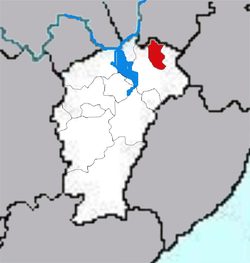Jingdezhen
| Jǐngdézhèn Shì 景德镇 市 Jingdezhen |
||
|---|---|---|
 Bahnhofsplatz |
||
|
|
||
| Coordinates | 29 ° 18 ' N , 117 ° 12' E | |
 Jingdezhen is located in the north of Jiangxi Province |
||
| Basic data | ||
| Country | People's Republic of China | |
| region | East china | |
| province | Jiangxi | |
| ISO 3166-2 | CN-JX | |
| status | District-free city | |
| structure | 2 city districts, 1 district, 1 urban district | |
| height | 35 m | |
| surface | 5256 km² | |
| Residents | 1,554,000 (2007) | |
| density | 295.7 Ew. / km² | |
| Post Code | 333000 | |
| Telephone code | +86 (0) 798 | |
| Time zone | China Standard Time (CST) UTC +8 |
|
| License Plate | 赣 H | |
| Website | www.jdz.gov.cn | |
| politics | ||
| mayor | Yan Ganhui | |
Jingdezhen ( Chinese 景德鎮 市 / 景德镇 市 , Pinyin Jǐngdézhèn Shì ) is a district-free city in the Chinese province of Jiangxi , which is known as the porcelain capital (瓷 都 ci du) of China.
Jingdezhen originally had the name Changnanzhen (昌 南鎮) due to its location on the Chang River , but was renamed during the Song Dynasty after the government motto of the Jingde emperor , who covered the porcelain needs of his court with porcelain from Jingdezhen and the production there thus promoted. During the Ming Dynasty , Jingdezhen was officially named an "Imperial Production Facility" for porcelain, in which, in addition to the private kilns, kilns were now run under imperial management and control.
The porcelain production was conditioned by the rich kaolin deposits, the vast forests (fuel for the kilns) and the location on the river for the safe transport of ceramics. Throughout the various dynasties, the different emperors in China had their own preferences for the styles of ceramics produced in Jingdezhen, but the city was mainly known abroad for its blue and white porcelain .
The place, which until then had belonged to Fuliang County , received city rights in 1927 and was directly subordinate to the provincial government. However, this was reversed just two years later. In April 1949, Jingdezhen was raised to the rank of (independent) city for the second time. From June to September of the same year the city was only called "Jingde" because the third character ( zhen = large community) had been removed from the name. But that turned out to be impractical, since the administrative term had long since become part of the name. In 1953, Jingdezhen was finally raised to the rank of prefecture-level city.
Jingdezhen has an area of 5,263 km² and approx. 1.53 million inhabitants (end of 2004). Kaolin , coal and manganese are produced in the city area .
The Hutian kiln site in the urban area , the town houses on Xiangji Alley (祥 集 弄 民宅, Xiángjílòng mínzhái) and the site of the Yuyaochang kiln (御窑 厂 窑址, Yùyáochǎng yáo zhǐ) are on the list of monuments of the People's Republic of China .
Administrative structure
At the county level, Jingdezhen is made up of two city districts, one district and one urban district. These are:
- Zhushan District (珠 山区), 31 km², 270,000 inhabitants (end of 2002), center, seat of the city government;
- Changjiang District (昌江 区), 392 km², 150,000 inhabitants (end of 2002);
- Fuliang District (浮梁 县), 2,867 km², 280,000 inhabitants (end of 2002), capital: Fuliang Municipality (浮梁 镇);
- City of Leping (乐平 市), 1,973 km², 770,000 inhabitants (end of 2002).
Web links
swell
- ↑ SJ Vainker: Chinese Pottery and Porcelain . George Braziller, Inc., New York 1991.

